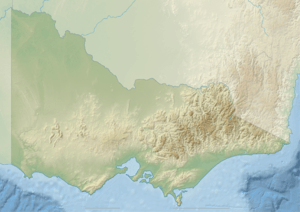Rose River (Victoria)
| Rose | |
| River[1] | |
| Country | Australia |
|---|---|
| State | Victoria |
| Regions | Victorian Alps (IBRA), Victorian Alps |
| Local government areas | Alpine Shire, Wangaratta |
| Part of | North-East Murray catchment, Murray-Darling basin |
| Source | Cobbler Plateau, Victorian Alps |
| - location | below Mount Cobbler |
| - elevation | 1,030 m (3,379 ft) |
| - coordinates | 36°59′54″S 146°30′59″E / 36.99833°S 146.51639°E |
| Mouth | confluence with the Dandongadale River |
| - location | near Dandongadale |
| - elevation | 298 m (978 ft) |
| - coordinates | 36°48′19″S 146°37′53″E / 36.80528°S 146.63139°ECoordinates: 36°48′19″S 146°37′53″E / 36.80528°S 146.63139°E |
| Length | 41 km (25 mi) |
| National park | Mount Buffalo National Park |
| [2] | |
The Rose River, a perennial river[1] of the North-East Murray catchment of the Murray-Darling basin, is located in the alpine region of Victoria, Australia. It flows from the northern slopes of the Mount Buffalo National Park in the Australian Alps, joining with the Dandongadale River in remote national park territory.[2]
Location and features
The Rose River rises below Mount Cobbler, west of the Cobbler Plateau and the Barry Mountains, at an elevation exceeding 1,000 metres (3,300 ft) above sea level. The river flows generally north by east, most of its course through the remote national park before reaching its confluence with the Dandongadale River within the Mount Buffalo National Park. The river descends 730 metres (2,400 ft) over its 41-kilometre (25 mi) course.[2]
See also
References
- 1 2 "Rose River: 24665". Vicnames. Retrieved 11 July 2014.
- 1 2 3 "Map of Rose River, VIC". Bonzle Digital Atlas of Australia. Retrieved 11 July 2014.
